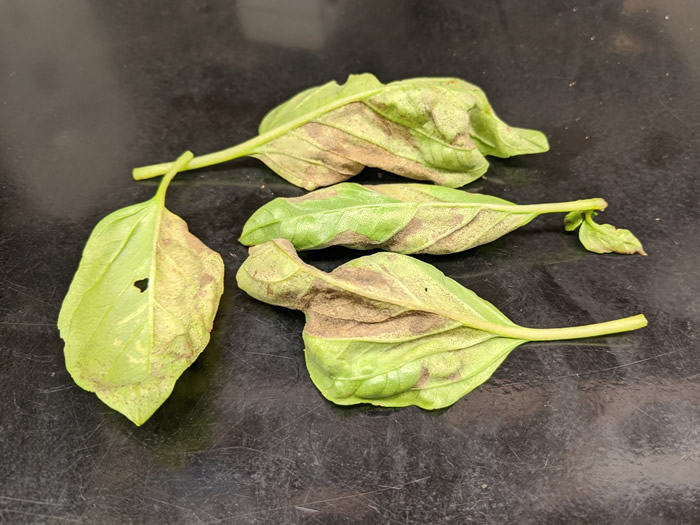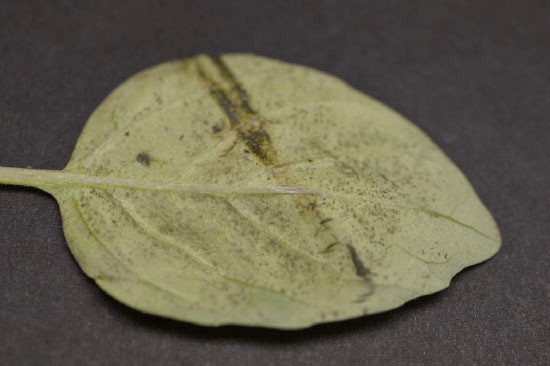Issue 8, July 29, 2020
Basil Downy Mildew
Basil downy mildew has been detected at several locations in northeast and east-central Illinois. This disease affects both homeowners growing a few basil plants for fresh harvest and commercial producers.

Basil Downy Mildew Photo: University of Illinois Plant Clinic
According to Dr. Babadoost, a professor in the Department of Crop Sciences at the University of Illinois who specializes in diseases of vegetable crops, this disease is serious for Illinois growers. Approximately 600 acres of basil are planted in Illinois, which has become one of the leading states in basil production in the country. Basil is a high-value crop, valued between $10,000 and $20,000 per acre.
Basil downy mildew is caused by Peronospora belbahri, a fungal-like oomycete (also known as a water mold). While there are a number of other important downy mildew diseases, including the infamous impatiens downy mildew, basil downy mildew is host specific and will not infect other species. It flourishes in cooler, wet weather, so the disease is generally worst at the beginning and end of the growing season. Hot, dry weather causes the pathogen to go dormant. Symptoms first appear as diffuse yellow areas on the top side of leaves. The pathogen produces spores on the underside of leaves, giving them a dirty appearance. A hand lens can be used to look for spores and the translucent, thread-like structures that produce them. Under magnification, the undersides of the leaves appear to be covered in grey fuzz. The disease progresses quickly, with affected leaves turning brown and falling from the plant; an entire plant can be defoliated within a few days.

Underside of a basil leaf infected with basil downy mildew; clumps of spores of the pathogen give the leaf the characteristic dirty, fuzzy appearance.
It is unknown if the pathogen can survive the winter in Illinois. It is thought that it overwinters in greenhouses, or travels in on cuttings. The spores can travel large distances by wind. A small initial number of spores can quickly lead to a huge infestation.
Dr. Babadoost’s laboratory has been conducting basil downy mildew fungicide trials since 2009. Because this pathogen is known to develop resistance to fungicides quickly, chemicals with different modes of action should be used. For commercial producers, there are a few chemical fungicides that are very effective against this pathogen, but they require a pesticide applicator’s license and up to 17 applications a season. Dr. Babadoost recommends alternating the following fungicide combinations: at weekly intervals:
- Azoxystrobin (Quadris 2.08SC (15.5 fl oz/A)) + potassium phosphite (ProPhyt SC (4 pt/A))
- Cyazofamid (Ranman 400SC (3 fl oz/A)) + potassium phosphite (ProPhyt SC (4 pt/A))
- Revus 209SC (8 fl oz/A) plus potassium phosphite (ProPhyt SC (4 pt/A))
We do not have effective compounds for managing downy mildew in organic basil production.
Chlorothalonil, a non-selective fungicide available under numerous trade names to individual gardeners, has been shown to be somewhat effective. Copper can also be used, but like chlorothalonil, it is not very effective.
Sanitation (removing and destroying diseased plants) is an important management technique. Plants should be carefully inspected at the nursery or garden store before being brought home. Because the pathogen needs moisture to thrive, reducing humidity and leaf wetness is important. Maximizing planting distances, planting in areas of full sun and air movement, and watering at the base of the plant are cultural techniques that can help reduce moisture on or around the plant, and help reduce disease. Several basil cultivars resistant to downy mildew were recently released. However, even resistant basils are infected when conditions are conducive for the development of the disease. Dr. Babadoost reports that basil downy mildew is less virulent towards red or purple basil, which can be used as an alternative to the popular sweet basil.
Authors:
Travis Cleveland
Diane Plewa